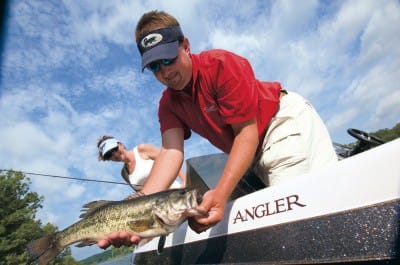Submitted By:
Kevin Vida – Pro Angler and USA Guest Author
 After a long winter off the water, once anglers turn the calendar to March, most of them start thinking about going after pre-spawn bass. Up in my neck of the woods (Michigan) most of the lakes still have ice on the water. But the farther south you go, the water temperatures are starting to rise and bass are easing into their pre-spawn transition.
After a long winter off the water, once anglers turn the calendar to March, most of them start thinking about going after pre-spawn bass. Up in my neck of the woods (Michigan) most of the lakes still have ice on the water. But the farther south you go, the water temperatures are starting to rise and bass are easing into their pre-spawn transition.
In most places – from mid-United State and points south – the bass are within about a month (give or take) of beginning to spawn. Remember: the further north you are, the later these activities will take place; the further south you are, the earlier it will happen. As part of my pre-spawn fishing strategy, I am looking for staging areas; places where schools fish are staging and actively feeding in anticipation of the spawn.
Mostly, I am looking for areas that lead to big, spawning flats. I look for big channel swings adjacent to spawning flats or go to the backs of creeks where channel swings can indicate deeper water – or submerged cover – that will hold pre-spawning fish.
By looking at topographic maps and using the GPS in my boat, I identify channel swings in the main lake and begin my search with a lipless crankbait. My favorite search bait this time of year is a ½-ounce Frenzy Rattl’r. I’m big on natural colors – even with hard baits – and I exclusively use the Red Craw pattern for this tactic. Though the water temperatures during this time of the year might be as low 45 degrees in some places, this bait produces. A few years ago, I set out on my home lake in Michigan two days after ice out. My intention was to catch bass on a lipless crankbait, though everyone doubted that I would. By the end of the day I had caught several nice fish, including a pair that I would love to have in the livewell at any tournament.
The reason that this bait works so well is that the fish will actively pursue it and it gets down deep enough – though not too deep – the target these areas. Tied to either 12-pound Trilene 100% Fluorocarbon line (in open water) or 15-pound (in areas with heavy grass or other cover) that is spooled on a high-speed (7.1:1) Abu Garcia REVO STX, I will start my casts 100 yards from the area where the channel swings meets the spawning flat. Not just blind casting, I am careful to mark my casts so that my bait touches the water every 25 feet. I learned this lesson the hard way: back before I used to mark my casts every 25 feet, I skipped an area out of which my co-angler caught a giant – on a Frenzy Rattl’r.
In open water, I will pair the 12-pound Trilene 100% Fluorocarbon with a seven-foot, medium-action Fenwick Techna AV; for areas with grass and wood, I prefer the seven-foot, medium-heavy Techna AV because it allows me to drive that hook in the fish’s mouth more easily.
Another way to approach pre-spawn fish this time of the year (when the water is 45-60 degrees), is to go into the backs of creeks where the shallow water is warmed more quickly by the sun. Often, the last big of structure before the end of the creek arm can hold a good number of fish – including the big pre-spawn females that are ready to eat.
To catch these fish, I like a ½- or ¾-ounce, Green Pumpkin Berkley Gripper Football Jig tipped with either a Green Pumpkin PowerBait Chigger Craw or Chigger Chunk. I locate the areas in the backs of creeks where the creek channel swings to the bank. Using a standard-speed REVO STX spooled with 17-pound Trilene 100% Fluorocarbon line and using a Fenwick Elite Tech Strokin’ Special rod, I back the baot away from the back and cast – not flip – into and around the visible cover. I will also cast towards submerged cover like rocks and stumps, dragging the jig on the bottom. There are hidden piles of wood and rock underwater in these areas, and this combination of structure and area can hold good populations of big females this time of year. I go into a “five-bit” mentality in this situation, carefully covering the water looking for five good fish. The jig helps me get down to the depth at which I need to be since channel swinging to the bank is a good sign of deeper water in the immediate area. If this channel swing to the bank also holds the last visible structure (wood, rock, etc.) in the creek arm, it’s an even better place to start.
It might still be cold where you live; the air might not get very warm very fast and it could be windy or fronts might be headed your way. But keep in mind that big bass are going to continue to prepare for the spawn whether you’re out there or not. So grab a jacket and some gloves and go figure out the pre-spawn bass on your favorite fishery so you can be one of the first ones to reel in a giant this year.



